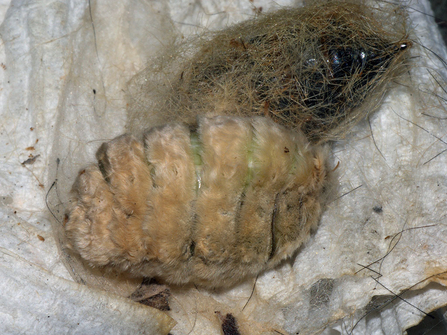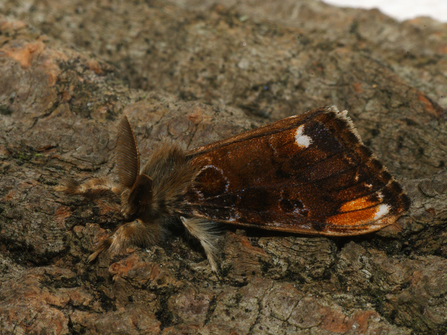The scarce vapourer’s range is restricted to just a few locations in Yorkshire and our surrounding counties. Sadly, it is also declining; a UK Biodiversity Action Plan species, listed under NERC section 41 Species of Principal Importance in England. It’s also the focus of one of our latest projects to understand just why it is so scarce.
The scarce vapourer moth

Scarce vapourer moth (female) - Ilia Ustyanstev - Creative Commons
Lifecycle
The male scarce vapourer is a typical looking moth – brown, a bit fluffy, with a pair of large antennae.
The female, however, is certainly not typical; when she emerges from her silky cocoon, she barely looks like a moth at all. She is plump, white, and practically wingless. Rather than putting her energy into growing wings to seek out a mate, she puts it into producing her egg and a pheromone to attract the males to her, which they sense using those large antennae.
Once mated, she lays her eggs inside the very cocoon she emerged from. The caterpillars hatch in late summer, then spend the winter hibernating on their food plant; when they wake up next spring they begin eating and grow beautifully colourful and fluffy. These pupate in late spring, and when the adults emerge in summer, the whole cycle begins again.
Vulnerbatility
So why are Scarce Vapourer so scarce? It’s certainly not for lack of food – the caterpillars feed on a range of trees and shrubs, like willow, hawthorn, and bramble, all very common species. Their life cycle is also similar to their cousin, the Common Vapourer (Orgyia antiqua) who also have flightless females, so surely it’s not this?
One thing the Scarce Vapourer does seem particularly vulnerable to is hedge cutting; it is usually found in hedgerows, and because it spend it’s whole life on the leaves of it’s food plant, any vigorous trimming of the hedge can completely remove a population. Contrast this to the Common Vapourer, which pupates on the ground or in crevices where it’s safe from mechanical hedge flails which are often used on farms and roadsides.
The hedge cutting theory is a possible explanation, but the species is still not well understood. So at Yorkshire Wildlife Trust, we are setting out to survey for this species, to determine it’s current distribution, and try to work out what factors are related to it’s decline.

Scarce vapourer moth (male) - (C) Ilia Ustyanstev - Creative Commons
How you can help
You can help in this project too, by keeping an eye out for it’s caterpillars, which are present up until the beginning of July. They are usually found in lowland areas, often nearby to water, such as bogs or wetlands, and are most likely to be spotted on sunny days when they bask on the leaves of hedges and shrubs.
If you think you’ve found Scarce Vapourer caterpillars, send an email to lucy.kucharik@ywt.org.uk or jim.horsfall@ywt.org.uk, including photographs and a grid reference or What3Words location. Your sightings could be valuable data we need to help conserve this special moth!
